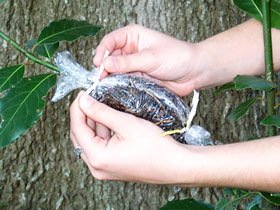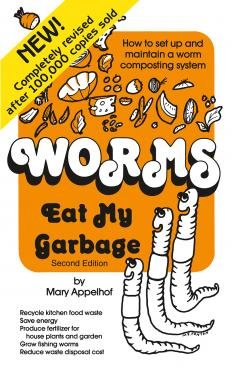


Propagating plants is a great way to make many plants from one, however many gardeners have not been very successful with rooting new plants from cuttings. Well there is a better way. Air layering is easy, and the success rate is much higher.
Perhaps you have a great plant you want to share with friends. Maybe you are moving soon and have a special plant that you can't dig and take with you. Or you may have a houseplant that's grown too tall for the room it's in. You can use air layering to root the top and replant it, thereby starting over with a much smaller plant.
First, select a section of stem, and with a knife cut all the way around it in two places about half an inch to an inch apart. Remove the ring of bark between the two cuts. In response to this wounding, the plant will start to grow a callous-type of tissue, like a scar tissue. From that callous, roots can form. Dust this wounded area with rooting hormone powder.
Next, take a piece of plastic to wrap around the stem and hold the rooting mix. I like to use an old bread wrapper but any plastic will do. Slice down the wrapper to open it up into a single sheet and then place it around the stem below the area where you exposed the wound. Take a twist tie and tie it around, securing the wrapper to the stem at the bottom.
Now fill the plastic wrapper with some moist potting soil or peat moss. It helps to wet it first as it's a lot easier to handle. You want to form it around the wounded area, then completely wrap the area with plastic. Then take another twist tie and wrap it around the top to secure the plastic wrap to the stem and hold the potting soil or peat moss firmly in place.
Wrap a piece of aluminum foil around the plastic to keep it dark inside. If the plant is in an outdoor location, the foil covering will also keep it from getting too hot. Within a few weeks, roots will start to form, and you'll occasionally need to open the bag and remoisten this mix.
Once you've got a good set of roots forming in the bag, you can cut off the plant below the rooted zone, and this top part becomes a new plant.
If you use this technique to root the top of a large houseplant, you may find that after you remove the rooted top, the stem below will resprout to form a bushier plant.
Try your luck at air layering this season. It is easy and fun. There is still time to make some new plants before cold weather arrives to shut down the season.
Air Layering for Difficult-to-Root Plants is an article from Texas A&M; Extension that provides easy instructions on air layering with good visuals to make the procedure even easier to understand. Give it a try and you'll soon been running around looking for plants to air layer!


 The food industry's digusting secrets exposed. How to protect yourself.
Click Here!
The food industry's digusting secrets exposed. How to protect yourself.
Click Here!
Discover how to easily build an attractive and affordable greenhouse that will grow anything in any conditions. Also, building your own greenhouse just makes economical sense. You can build a greenhouse at just a fraction of the cost of buying a pre-built one. Most pre-built greenhouse you buy need to be assembled anyway, you are really just paying hugely inflated prices for the material.

The book that started a backyard worm revolution! With more than 150,000 copies sold, this is the bestselling and remains the definitive guide to vermicomposting--a process using red worms to recycle human food waste into nutrient-rich fertilizer for plants. Author Mary Appelhof provides complete illustrated instructions on setting up and maintaining small-scale worm composting systems. Read More...


 The food industry's digusting secrets exposed. How to protect yourself.
Click Here!
The food industry's digusting secrets exposed. How to protect yourself.
Click Here!

The book that started a backyard worm revolution! With more than 150,000 copies sold, this is the bestselling and remains the definitive guide to vermicomposting--a process using red worms to recycle human food waste into nutrient-rich fertilizer for plants. Author Mary Appelhof provides complete illustrated instructions on setting up and maintaining small-scale worm composting systems. Read More...